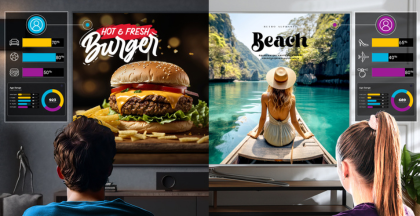Next level cloud-based video technology, with UHD quality
Advanced features to stream your live or linear content D2C
Deliver personalized live and linear streaming to all devices
Unify your video processing, from source to screen
Trust the world’s leading media SaaS platform
VOS®360 Media SaaS takes even the most complex workflow and abstracts it to a simple layer with guaranteed reliability. Receive content at the source, uplink to the cloud, insert and personalize the content, then distribute right to your viewer’s screen. Improve your viewer’s experience with reduced latency and exceptional encoding efficiency.
Reduce the average bandwidth by 50 percent with EyeQ™ content-aware encoding and latest developments in artificial intelligence. Discover how in our white paper.
Handle live event viewing peaks
Cloud geo-redundancy, source redundancy, and multi-CDN path diversity ensure resilient end-to-end video delivery for millions of simultaneous viewers.
You can optimize your live video delivery to enhance experiences with flexible and real-time scaling that handles peak viewing.
Launch ad-supported streaming TV
Enhance direct-to-consumer reach and boost engagement. VOS360 allows you to quickly create personalized channels using a new or existing library of assets to drive revenue.
Bypass ad blockers with DAI & SSAI
You can use a seamless, end-to-end architecture to deliver personalized to all of your subscribers. Integrate dynamic and server-side ad insertion into your video workflow with ease thanks to VOS360.
Deliver engaging video to captivate audiences
Choose your cloud, or even multiple clouds to deploy VOS providing you agility and flexibility. A vast ecosystem of pre-integrated partner applications, including leading digital rights management (DRM), watermarking, ad tech, over 20 CMS providers and automation partner accelerate your time to market.
You can optimize your live video delivery to enhance experiences with flexible and real-time scaling that handles peak viewing.
Choose your cloud provider
Choose your cloud, or even multiple clouds to deploy VOS providing you agility and flexibility.
Vast ecosystem of partner applications
A vast ecosystem of pre-integrated partner applications, including leading digital rights management (DRM), watermarking, ad tech, over 20 CMS providers and automation partner accelerate your time to market.
Real-time scaling & viewer peaks
You can optimize your live video delivery to enhance experiences with flexible and real-time scaling that handles peak viewing.
Engage audiences with VOS360
VOS360 applications

Sports events

SSAI & variants

Linear TV streaming

Broadcast in the cloud

Video on-demand

FAST platforms

Cloud distribution

Channel origination

VOS360 technical specifications
Ingest
Live ingest for transcoding
Includes compressed TS (MPEG-2, AVC, HEVC) sources, up to UHD.
Multi-bitrate TS live ingest for packaging (no transcoding)
Supports compressed TS AVC and HEVC sources. The streams can be received over managed networks (SMPTE-2022-1, 2022-2, 2022-7) and internet (SRT). Also supports RTMP live inputs.
Audio codecs
AAC, AC3
Data
Close caption, Teletext, DVB-Sub
Harmonic's ViBE® CP9000 and XOS can be used to ingest signals.
Transcoding
Harmonic PURE Compression Engine™
Advanced transcoding technology supports SD, HD and UHD formats, and MPEG-2, MPEG-4 AVC and HEVC codecs for broadcast and OTT delivery, providing groundbreaking video quality at the lowest possible bit rates and latency.
Harmonic EyeQ™ Content-Aware Encoding
Offers consistent, superior video quality for IPTV and OTT services, with up to a 50 percent reduction in bandwidth. This technology is built with artificial intelligence techniques to achieve better video quality at a lower bit rate and higher density. You can add this on to any Harmonic product.
Packaging
Optimize storage and ease upgrades with the addition of new packaging features. All formats are supported so that your content can be seen on virtually any device or social platform.
Powerful subtitling conversions for optimizing your application rendering.
Low latency for streaming live sports with no delays compared to broadcasts.
Encryption
Multi-CAS and Multi-DRM solutions for protecting your pay TV, OTT, and hybrid platforms.
AES and BISS provide scrambling for pay TV and are integrated with major DVB Simulcrypt and DVB-CAS conditional access systems for content protection.
DRM for OTT, including FairPlay and PlayReady for HLS, Widevine and PlayReady for MPEG-DASH, MPEG-CENC for CMAF (MPEG-DASH + HLS), and PlayReady for HSS. HKMS, CPIX, and specific APIs interface with Key Management Systems (KMS).
Origin
Delivers the full range of storage and bandwidth scalability expected from cloud-based deployments, including supporting private copy nPVR and large VOD catalogs.
Integrating VOS360 origin with a third-party CMS solution is simple thanks to the VOS API, which comes with online documentation and samples. In addition, with the number of VOS360 integrations that have already taken place, it is very likely your CMS solution is already covered.
SCTE 224 Blackout Management and Dynamic Ad Insertions are based on the manifest manipulation extension of the origin, and cover modern content distribution and monetization workflows.
Delivery
Prepare and distribute content to your audience in a single platform. Stream your VOD content, linear channels or live events directly to your App. VOS360 can even provide CDN services to keep it simple.
VOS360 can also distribute your linear channel over SRT to affiliates, for further customization, or to FAST platforms or even to DTH teleports.

Chief Technology Officer at Mola TV
Lead Pastor, at Trinity Christian Centre

Director of Business Solutions, at Hulman & Company









